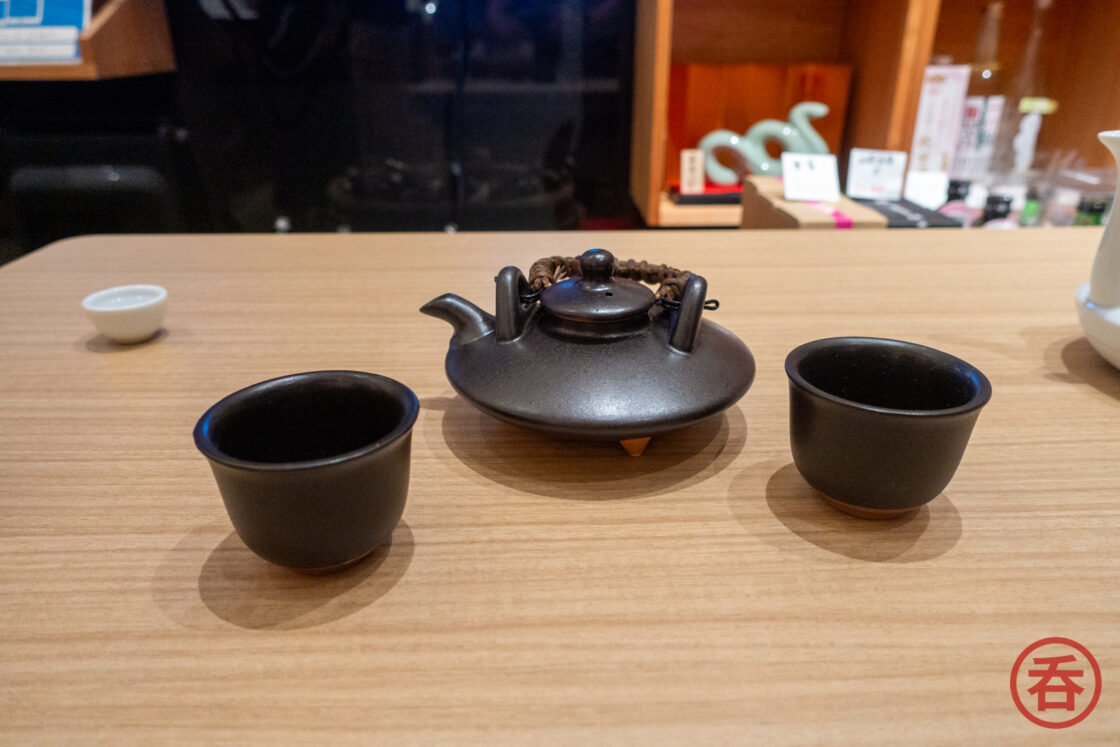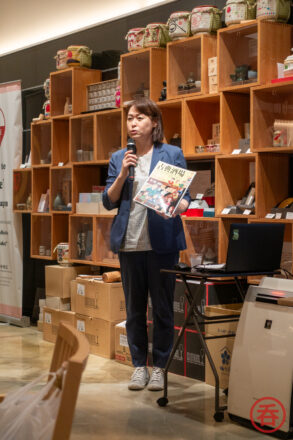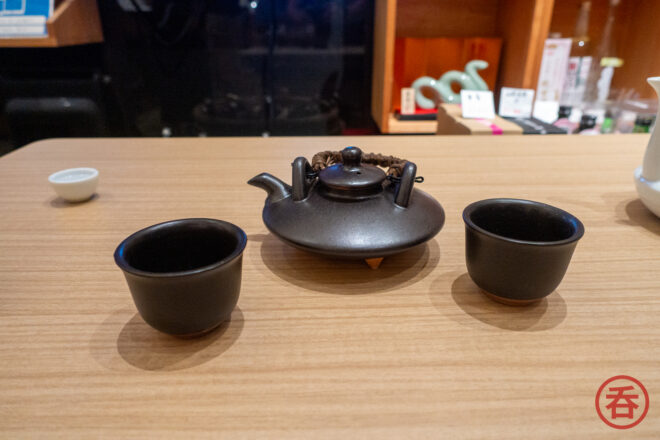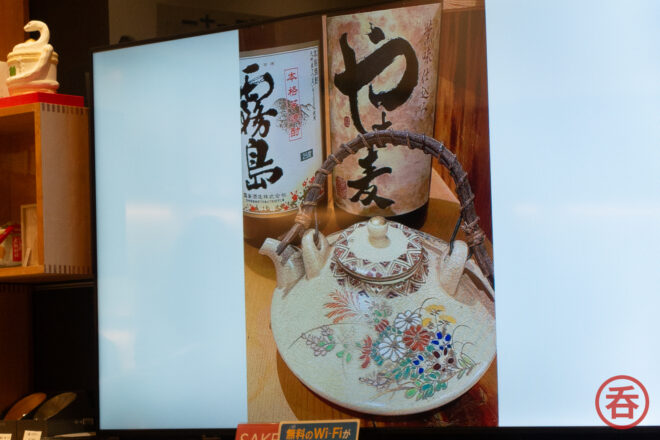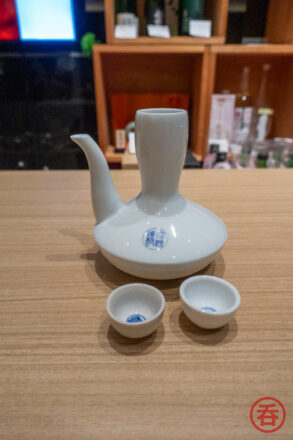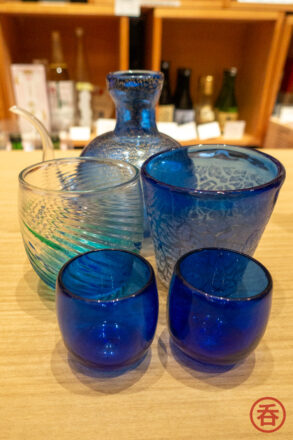At the invitation of JSS, members of the foreign media once again descended upon the JSS Information Center in Shimbashi for another seminar. Our focus this time was on the wide variety of drinkware used in shochu, and how both local needs and the drinks themselves have dictated their sizes, shapes, materials, and traditions.
The seminar this time around was led by Kiwako Kurashima, former editor of an izakaya magazine named Koten Sakaba (古典酒場, or “Drinking Spots: The Classics”) that ran from 2007 to 2013 and covered some 570 different spots to get some drinks. Though the print magazine is no longer published, Koten Sakaba lives on in blog form has been updated at least daily since around 2009. As you can imagine there’s a massive number of izakaya and drinking spots covered here — Kumamoto Prefecture alone has 277 entries in the category.
Kurashima-san’s business card conspicuously features the title “酔女,” which can read either suijo or eijo. At first glance that simply means “drunk woman.” A bit more digging reveals that the early 19th-century ukiyo-e artist Katsushika Oi, the third of Hokusai’s daughters, usually signed her work as 栄女, (which reads “Eijo”). But as she was apparently keen to drink a bit herself, she did a bit of play on words and signed some of her work as 酔女, again “Eijo.” If you can read a bit of 19th-century ukiyo-e kanji, you can see an example in “Three Women Playing Shamisen.”
Kagoshima: Sweet Potato (Imo) Shochu and Joka
If you want to drink your Kagoshima shochu in a very traditional fashion, you have three options:
Kuro Joka
Kuro (“black”) joka are made of Kuro Satsuma ware. Because they’re made from volcanic clay, these pieces have a big advantage: they can be placed directly over heat. Basically, you pour as much shochu as you like in the joka, heat it up (maybe over an irori/hearth since you’re probably already eating, right?), then dish it out as necessary to your actual drinking vessels.
The soil content of Kagoshima is such that it’s high in iron, enabling these pieces to mellow out your shochu a bit. Running them at higher heat can bring out more aromas, too. Another bonus: you usually don’t have to wash them. Just rinse and air dry.
Shiro Joka
Shiro (“white”) joka are made of Shiro Satsuma ware, which in the past was limited for use within the daimyo’s household. As a result, shiro joka were initially seen as being “for the rich” and not necessarily for use by the general public.
That might still be the case today. Unlike Kuro joka, shiro joka are not heat resistant, meaning you don’t want to put them over open flames.
Suzu Joka
The Edo Period saw the emergence of suzu, or tin joka. You won’t want to use these an an open flame either, but you can put them in a warm water bath.
Tin has a mellowing effect as well (something we’ve noted with Saburomaru’s famed pot stills), so these are perfect for making a maewari (mixing shochu and water the night before drinking it).
Recommended pairings
Being an izakaya fan, Kurashima-san also has some pairing recommendations for each region we’ll cover. If you can get your hands on any of these bites around you, you’re in for a treat.
- Sweet Potato Tempura
- Tonkotsu
- Kibinago with Miso
Kumamoto: Kuma Shochu and Gara and Choku
“Gara” means carafe and “choku” means cup. Wonder why the cups are so small? Kumamoto’s famed Kuma Shochu (a local variety of rice shochu) was traditionally served at 35% abv, so you didn’t need to put a lot back to feel it.
These days, since Kuma Shochu weighs in at 25% abv–and less if you’re mixing with water–you don’t necessarily need the smaller cups. They do give a nice traditional vibe though.
Recommended pairings
- Karashi Renkon
- Basashi (raw horse) with Hitomoji Guruguru
- Tofu Misozuke
- Ayu, specifically Shaku Ayu
- Grilled boar, or boiled boar served honekajiri style
Okinawa: Awamori and Karakara and Ryukyu Glass
Karakara
If you’ve spent time around awamori you’re probably already familiar with the karakara. Rumor has it the design is specifically such that it can’t be knocked over so easily when drinking. With awamori, that might be important…
The karakara’s other claim to fame is for the word “awamori” itself. Just as a venenciador aerates a sherry or a bartender might throw a cocktail, you’re supposed to pour the awamori out of the karakara into your cup from a decent height. The aeration causes the awamori to bubble up when it hits the cup — the “awa” in awamori means “bubble.”
Ryukyu Glass
A relatively recent invention, Ryukyu glass is said to have come around when Okinawans collected used beer and soda bottles from occupying US forces, smashed them to pieces if they weren’t already broken, and recycled them into new glass.
The bubbles in Ryukyu Glass aren’t a bug, by the way, they’re a feature.
If you’re in Okinawa, by the way, you might come across some Ryukyu Glass that has glow-in-the-dark specks of fluorite in it. Some might even claim that only “real” Ryukyu Glass contains fluorite. This is apparently all false — the fluorite glass comes from one of two suppliers, both in Osaka. It has nothing to do with Okinawan tradition or artistry.
Recommended pairings
- Rafute
- Sukugarasu
- Shimazushi with Wagarashi
Hi there! I created and run nomunication.jp. I’ve lived in Tokyo since 2008, and I am a certified Shochu Kikisake-shi/Shochu Sommelier (焼酎唎酒師), Cocktail Professor (カクテル検定1級), and I hold Whisky Kentei Levels 3 and JW (ウイスキー検定3級・JW級). I also sit on the Executive Committees for the Tokyo Whisky & Spirits Competition and Japanese Whisky Day. Click here for more details about me and this site. Kampai!

